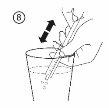
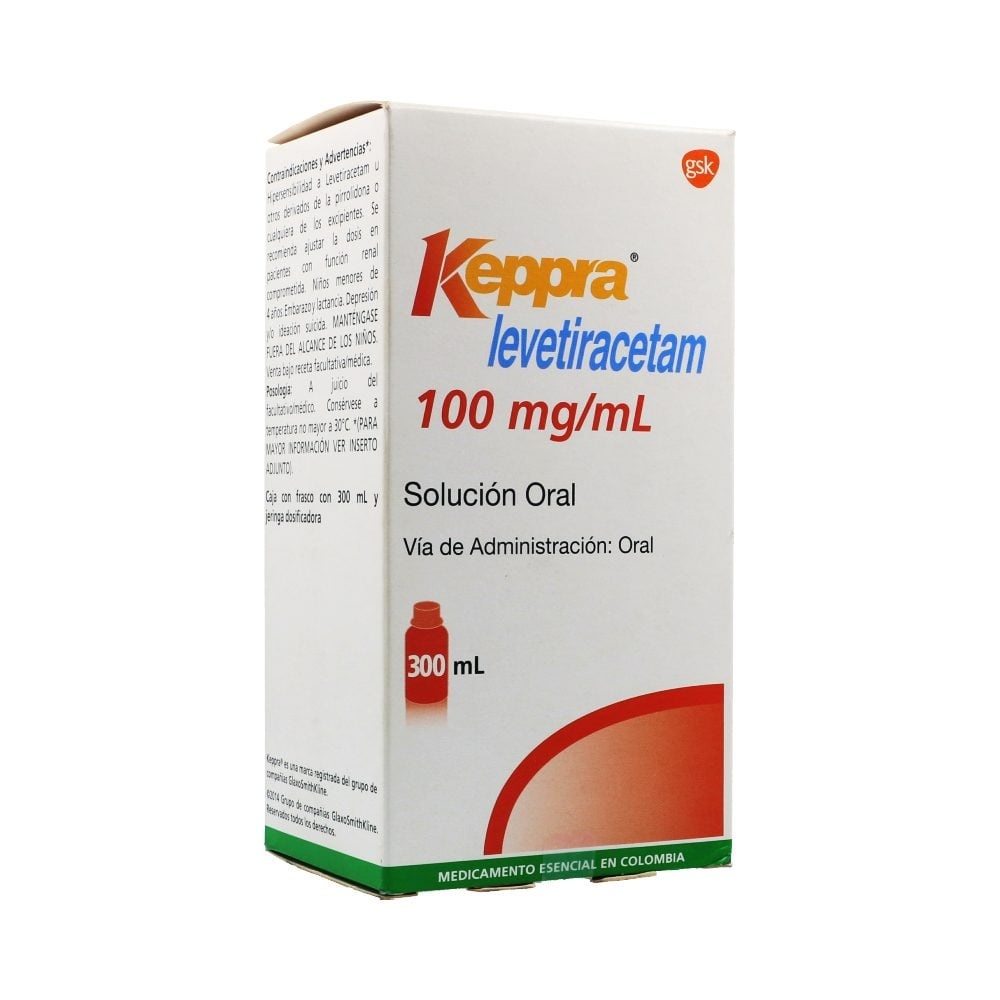
КЕППРА 100 мг/мл ОРАЛЬНЫЙ РАСТВОР

Спросите врача о рецепте на КЕППРА 100 мг/мл ОРАЛЬНЫЙ РАСТВОР

Инструкция по применению КЕППРА 100 мг/мл ОРАЛЬНЫЙ РАСТВОР
Введение
Инструкция: информация для пациента
Кеппра 100 мг/мл пероральная жидкость
Леветирацетам
Прочитайте внимательно всю инструкцию перед тем, как вы или ваш ребенок начнете принимать это лекарство, поскольку в ней содержится важная информация для вас.
- Сохраните эту инструкцию, поскольку вам может потребоваться перечитать ее.
- Если у вас есть какие-либо сомнения, проконсультируйтесь с вашим врачом или фармацевтом.
- Это лекарство было назначено только вам и не должно быть передано другим людям, даже если у них такие же симптомы, как у вас, поскольку оно может нанести им вред.
- Если вы испытываете побочные эффекты, проконсультируйтесь с вашим врачом или фармацевтом, даже если это побочные эффекты, не указанные в этой инструкции. См. раздел 4.
Содержание инструкции
- Что такое Кеппра и для чего она используется
- Что вам нужно знать перед началом приема Кеппры
- Как принимать Кеппру
- Возможные побочные эффекты
- Хранение Кеппры
- Содержание упаковки и дополнительная информация
1. Что такое Кеппра и для чего она используется
Леветирацетам является противоэпилептическим препаратом (лекарством для лечения судорог при эпилепсии).
Кеппра используется:
- в качестве монотерапии у взрослых и подростков от 16 лет с недавно диагностированной эпилепсией для лечения одной формы эпилепсии. Эпилепсия - это заболевание, при котором пациенты испытывают приступы (судороги). Леветирацетам используется для лечения формы эпилепсии, при которой приступы сначала поражают только одну сторону мозга, но могут затем распространиться на более обширные области в両 сторон мозга (парциальные приступы с или без вторичной генерализации). Ваш врач назначил леветирацетам, чтобы уменьшить количество приступов.
- в комбинации с другими противоэпилептическими препаратами для лечения:
- парциальных приступов с или без вторичной генерализации у взрослых, подростков, детей и младенцев от 1 месяца жизни.
- миоклонических приступов (коротких, похожих на удар, сокращений мышц или группы мышц) у взрослых и подростков от 12 лет с ювенильной миоклонической эпилепсией.
- примарных генерализованных тónico-клонических приступов (больших приступов, включая потерю сознания) у взрослых и подростков от 12 лет с идиопатической генерализованной эпилепсией (типом эпилепсии, который, как полагают, имеет генетическую причину).
2. Что вам нужно знать перед началом приема Кеппры
Не принимайте Кеппру
- Если вы аллергичны к леветирацетаму, производным пиролидона или любому другому компоненту этого препарата (перечисленному в разделе 6).
Предостережения и меры предосторожности
Проконсультируйтесь с вашим врачом перед началом приема Кеппры
- Если у вас есть проблемы с почками, следуйте инструкциям вашего врача, который решит, нужно ли корректировать дозу.
- Если вы заметите любое снижение роста вашего ребенка или неожиданное развитие полового созревания, свяжитесь с вашим врачом.
- Небольшое количество людей, принимающих противоэпилептические препараты, такие как Кеппра, испытывали мысли о причинении вреда себе или суицидальные мысли. Если у вас есть какие-либо симптомы депрессии и/или суицидальные мысли, свяжитесь с вашим врачом.
- Если у вас есть медицинские или семейные анамнезы нерегулярного сердечного ритма (видимого на электрокардиограмме), или если у вас есть заболевание и/или вы принимаете лечение, которое делает вас склонным к сердечным аритмиям или нарушениям баланса электролитов.
Сообщите вашему врачу или фармацевту, если любой из следующих побочных эффектов ухудшается или длится более нескольких дней:
- Аномальные мысли, чувство раздражительности или реакция более агрессивно, чем обычно, или если вы или ваши близкие заметили значительные изменения в вашем настроении или поведении.
- Ухудшение эпилепсии:
В редких случаях приступы могут ухудшиться или стать более частыми, в основном в течение первого месяца после начала лечения или увеличения дозы.
В очень редкой форме ранней эпилепсии (эпилепсия, связанная с мутациями SCN8A), которая вызывает множественные типы приступов и потерю навыков, вы можете заметить, что приступы продолжаются или ухудшаются во время лечения.
Если вы испытываете любой из этих новых симптомов, принимая Кеппру, обратитесь к врачу как можно скорее.
Дети и подростки
- Монотерапия Кеппрой не показана у детей и подростков младше 16 лет.
Применение Кеппры с другими препаратами
Сообщите вашему врачу или фармацевту, если вы принимаете, недавно принимали или можете принимать любой другой препарат.
Не принимайте макрогол (препарат, используемый как слабительное) в течение часа до и после приема леветирацетама, поскольку это может уменьшить его эффект.
Беременность и лактация
Если вы беременны или кормите грудью, считаете, что можете быть беременной или планируете стать беременной, проконсультируйтесь с вашим врачом перед использованием этого препарата. Леветирацетам можно использовать во время беременности только после тщательной оценки и если ваш врач считает это необходимым.
Не прекращайте лечение без предварительной консультации с вашим врачом.
Нельзя полностью исключить риск врожденных дефектов у ребенка.
Грудное вскармливание не рекомендуется во время лечения.
Вождение и использование машин
Кеппра может повлиять на вашу способность управлять транспортными средствами или работать с инструментами или машинами, поскольку она может вызывать сонливость. Это более вероятно в начале лечения или при увеличении дозы. Не следует управлять транспортными средствами или работать с машинами до тех пор, пока не будет проверено, что ваша способность выполнять эти действия не нарушена.
Кеппра содержит метилпарабен, пропилпарабен и мальтитол
Кеппра 100 мг/мл пероральная жидкость, содержащая метилпарабен (Е218) и пропилпарабен (Е216), может вызывать аллергические реакции (возможно, задержанные).
Кеппра пероральная жидкость также содержит мальтитол. Если ваш врач сообщит вам, что у вас есть непереносимость некоторых сахаров, проконсультируйтесь с вашим врачом перед приемом этого препарата.
Кеппра содержит натрий
Этот препарат содержит менее 1 ммоль натрия (23 мг) на мл; это означает, что он практически не содержит натрия.
3. Как принимать Кеппру
Следуйте точно инструкциям по применению этого препарата, указанным вашим врачом или фармацевтом. В случае сомнений проконсультируйтесь с вашим врачом или фармацевтом.
Кеппра должна приниматься дважды в день, один раз утром и один раз вечером, примерно в одно и то же время каждый день.
Принимайте пероральную жидкость согласно инструкциям вашего врача.
Монотерапия (от 16 лет)
Взрослые (≥18 лет) и подростки (от 16 лет):
Для пациентов от 4 лет, измерьте необходимую дозу с помощью шприца на 10 мл, включенного в упаковку.
Рекомендуемая доза: Кеппра принимается дважды в день, в две равные дозы, каждая доза отдельно между 5 мл (500 мг) и 15 мл (1500 мг).
Когда вы начинаете принимать Кеппру, ваш врач назначит нижнюю дозув течение двух недель перед назначением минимальной суточной дозы.
Комбинированная терапия
Доза для взрослых и подростков (от 12 до 17 лет):
Для пациентов от 4 лет, измерьте необходимую дозу с помощью шприца на 10 мл, включенного в упаковку.
Рекомендуемая доза: Кеппра принимается дважды в день, в две равные дозы, каждая доза отдельно между 5 мл (500 мг) и 15 мл (1500 мг).
Доза для детей от 6 месяцев жизни:
Ваш врач назначит наиболее подходящую лекарственную форму Кеппры в зависимости от возраста, веса и дозы.
Для детей от 6 месяцев до 4 лет, измерьте необходимую дозу с помощью шприца на 3 мл, включенного в упаковку.
Для детей старше 4 лет, измерьте необходимую дозу с помощью шприца на 10 мл, включенного в упаковку.
Рекомендуемая доза: Кеппра принимается дважды в день, в две равные дозы, каждая доза отдельно между 0,1 мл (10 мг) и 0,3 мл (30 мг) на килограмм веса ребенка (см. примеры доз в следующей таблице).
Доза для детей от 6 месяцев жизни:
Вес | Начальная доза: 0,1 мл/кг дважды в день | Максимальная доза: 0,3 мл/кг дважды в день |
6 кг | 0,6 мл дважды в день | 1,8 мл дважды в день |
8 кг | 0,8 мл дважды в день | 2,4 мл дважды в день |
10 кг | 1 мл дважды в день | 3 мл дважды в день |
15 кг | 1,5 мл дважды в день | 4,5 мл дважды в день |
20 кг | 2 мл дважды в день | 6 мл дважды в день |
25 кг | 2,5 мл дважды в день | 7,5 мл дважды в день |
От 50 кг | 5 мл дважды в день | 15 мл дважды в день |
Дозировка у младенцев (от 1 месяца до 6 месяцев):
Для младенцев от 1 месяца до 6 месяцев, измерьте необходимую дозу с помощью шприца на 1 мл, включенного в упаковку.
Рекомендуемая доза: Кеппра принимается дважды в день, в две равные дозы, каждая доза отдельно между 0,07 мл (7 мг) и 0,21 мл (21 мг) на килограмм веса младенца (см. примеры доз в следующей таблице).
Доза для младенцев (от 1 месяца до 6 месяцев):
Вес | Начальная доза: 0,07 мл/кг дважды в день | Максимальная доза: 0,21 мл/кг дважды в день |
4 кг | 0,3 мл дважды в день | 0,85 мл дважды в день |
5 кг | 0,35 мл дважды в день | 1,05 мл дважды в день |
6 кг | 0,45 мл дважды в день | 1,25 мл дважды в день |
7 кг | 0,5 мл дважды в день | 1,5 мл дважды в день |
Способ применения:
После измерения правильной дозы с помощью подходящего шприца, пероральную жидкость Кеппры можно разбавить в стакане воды или в бутылке. Вы можете принимать Кеппру с или без еды. После перорального приема леветирацетама может ощущаться горький вкус.
Инструкции по использованию шприца:
- Открыть флакон: нажать на крышку и повернуть против часовой стрелки (рисунок 1)

- Следуйте этим шагам в первый раз, когда принимаете Кеппру:
- Отделите адаптер для шприца для перорального использования (рисунок 2).
- Поместите адаптер на верхнюю часть флакона (рисунок 3). Убедитесь, что он хорошо закреплен на месте. Не нужно удалять адаптер после использования.

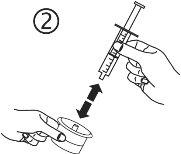
- Следуйте этим шагам каждый раз, когда принимаете Кеппру:
- Поместите шприц для перорального использования в отверстие адаптера (рисунок 4).
- Положите флакон вниз (рисунок 5).
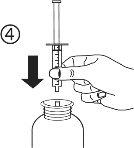
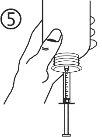
- Держите флакон вниз, одной рукой, и используйте другую руку, чтобы наполнить шприц для перорального использования.
- Потяните поршень вниз, чтобы наполнить шприц для перорального использования небольшим количеством раствора (рисунок 5А).
- Затем нажмите поршень вверх, чтобы удалить любые возможные пузырьки воздуха (рисунок 5Б).
- Опустите поршень до отметки на шприце для перорального использования, соответствующей дозе в миллилитрах (мл), назначенной вашим врачом (рисунок 5В). Возможно, поршень снова поднимется по цилиндру при первой администрации. Поэтому убедитесь, что поршень находится в положении до тех пор, пока шприц не будет отключен от флакона.


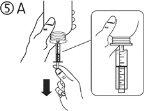
- Положите флакон вверх (рисунок 6А). Удалите шприц из адаптера (рисунок 6Б).


- Выпустите содержимое шприца в стакан воды или в бутылку, опустив поршень до конца шприца (рисунок 7).

|
|
| |
| |
|
Продолжительность лечения:
- Кеппра используется как постоянное лечение. Вы должны продолжать лечение Кеппрой в течение времени, указанного вашим врачом.
- Не прекращайте лечение без рекомендации вашего врача, поскольку это может увеличить количество приступов.
Если вы приняли слишком много Кеппры
Возможные побочные эффекты передозировки Кеппры включают сонливость, агитацию, агрессивность, снижение бдительности,抑нение дыхания и кому.
Свяжитесь с вашим врачом, если вы приняли больше раствора, чем должно быть. Ваш врач определит лучшее возможное лечение передозировки.
Если вы пропустили прием Кеппры:
Свяжитесь с вашим врачом, если вы пропустили одну или несколько доз.
Не принимайте двойную дозу, чтобы компенсировать пропущенные дозы.
Если вы прекратили лечение Кеппрой:
Прекращение лечения Кеппрой должно осуществляться постепенно, чтобы избежать увеличения количества приступов. Если ваш врач решит прекратить ваше лечение Кеппрой, он даст вам инструкции по постепенному прекращению приема Кеппры.
Если у вас есть какие-либо другие вопросы о применении этого препарата, проконсультируйтесь с вашим врачом или фармацевтом.
4. Возможные побочные эффекты
Как и все лекарства, Кеппра может вызывать побочные эффекты, хотя не все люди испытывают их.
Сообщите своему врачу немедленно или обратитесь в отделение неотложной помощи ближайшей больницы, если вы испытываете:
- слабость, головокружение или затруднение дыхания, поскольку это может быть признаком тяжелой аллергической реакции (анафилактической)
- отек лица, губ, языка или горла (отек Квинке)
- симптомы гриппа и сыпь на лице, за которыми следует длительная сыпь с повышенной температурой, повышенными уровнями печеночных ферментов в крови и увеличением количества определенных типов белых кровяных клеток (эозинофилия), увеличенные лимфатические узлы и поражение других органов тела (реакция гиперчувствительности к лекарству с эозинофилией и системными симптомами (DRESS))
- симптомы, такие как низкий объем мочи, усталость, тошнота, рвота, спутанность сознания и отек ног, рук или ног, поскольку это может быть признаком внезапного снижения функции почек
- кожная сыпь, которая может образовывать пузыри и выглядеть как небольшие мишени (центральные темные точки, окруженные более светлой областью, с темным кольцом вокруг края) (эритема многоформная)
- общая сыпь с пузырями и шелушением кожи, особенно вокруг рта, носа, глаз и гениталий (синдром Стивенса-Джонсона)
- более тяжелая форма, вызывающая шелушение кожи на более чем 30% поверхности тела (токсический эпидермальный некролиз)
- признаки серьезных изменений психики или если кто-то рядом с вами замечает признаки спутанности сознания, сонливости (заторможенности), амнезии (потери памяти), ухудшения памяти (забывчивости), аномального поведения или других неврологических симптомов, включая непроизвольные или неконтролируемые движения. Эти симптомы могут быть признаками энцефалопатии.
Наиболее часто сообщаемые побочные эффекты - насофарингит, сонливость (чувство сна), головная боль, усталость и головокружение. Побочные эффекты, такие как чувство сна, чувство слабости и головокружение, могут быть более частыми при начале лечения или увеличении дозы. Однако эти побочные эффекты должны уменьшаться со временем.
Очень часто: могут поражать более 1 из 10 человек
- насофарингит;
- сонливость (чувство сна), головная боль.
Часто: могут поражать до 1 из 10 человек
- анорексия (потеря аппетита);
- депрессия, враждебность или агрессивность, тревога, бессонница, нервозность или раздражительность;
- припадки, нарушение равновесия, головокружение (чувство неустойчивости), летаргия (отсутствие энергии и энтузиазма), тремор (непроизвольный тремор);
- вертиго (чувство вращения);
- кашель;
- боль в животе, диарея, диспепсия (тяжелая пищеварение, изжога и кислотность), рвота, тошнота;
- кожная сыпь;
- астения/усталость (чувство слабости).
Не часто: могут поражать до 1 из 100 человек
- уменьшение количества тромбоцитов, уменьшение количества белых кровяных клеток;
- потеря веса, набор веса;
- попытка самоубийства и мысли о самоубийстве, изменения психики, аномальное поведение, галлюцинации, гнев, спутанность сознания, паническая атака, эмоциональная нестабильность/изменения настроения, агитация;
- амнезия (потеря памяти), ухудшение памяти (потеря памяти), аномальная координация/атаксия (нарушение координации движений), парестезия (ползание), изменения внимания (потеря концентрации);
- диплопия (двойное зрение), размытое зрение;
- повышенные/анормальные значения в тестах на функцию печени;
- потеря волос, экзема, зуд;
- слабость мышц, миалгия (боль в мышцах);
- травма.
Редко: могут поражать до 1 из 1 000 человек
- инфекция;
- уменьшение всех типов кровяных клеток;
- тяжелые аллергические реакции (DRESS, анафилактическая реакция (тяжелая и серьезная аллергическая реакция), отек Квинке (отек лица, губ, языка и горла));
- уменьшение концентрации натрия в крови;
- самоубийство, расстройства личности (проблемы поведения), аномальное мышление (медленное мышление, трудности с концентрацией);
- делирий;
- энцефалопатия (см. раздел "Сообщите своему врачу немедленно" для подробного описания симптомов);
- припадки могут ухудшаться или возникать чаще;
- неконтролируемые мышечные спазмы, поражающие голову, туловище и конечности, трудности с контролем движений, гиперкинез (гиперактивность);
- изменение сердечного ритма (электрокардиограмма);
- панкреатит (воспаление поджелудочной железы);
- почечная недостаточность, гепатит (воспаление печени);
- внезапное снижение функции почек;
- кожная сыпь, которая может привести к образованию пузырей, выглядящих как небольшие мишени (центральные темные точки, окруженные более светлой областью, с темным кольцом вокруг края) (эритема многоформная), общая сыпь с пузырями и шелушением кожи, особенно вокруг рта, носа, глаз и гениталий (синдром Стивенса-Джонсона) и более тяжелая форма, вызывающая шелушение кожи на более чем 30% поверхности тела (токсический эпидермальный некролиз):
- рабдомиолиз (разрушение мышечной ткани) и увеличение креатинфосфокиназы в крови. Распространенность значительно выше у японских пациентов по сравнению с неяпонскими пациентами;
- хромота или трудности с ходьбой;
- комбинация лихорадки, мышечной жесткости, нестабильного артериального давления и частоты сердечных сокращений, спутанности сознания, состояния низкого уровня сознания (могут быть признаками расстройства, называемого мalignant нейролептический синдром). Распространенность значительно выше у японских пациентов по сравнению с неяпонскими пациентами.
Очень редко: могут поражать до 1 из 10 000 человек
- мысли или чувства, которые не желательны и повторяются, или импульс делать что-то снова и снова (обсессивно-компульсивное расстройство).
Сообщение о побочных эффектах
Если вы испытываете любой побочный эффект, проконсультируйтесь с вашим врачом или фармацевтом, даже если это возможные побочные эффекты, которые не перечислены в этом листке. Вы также можете сообщить о них напрямую через национальную систему уведомления, включенную в Приложение V. Сообщая о побочных эффектах, вы можете внести свой вклад в предоставление более подробной информации о безопасности этого лекарства.
5. Хранение Кеппры
Храните это лекарство в недоступном для детей месте.
Не используйте это лекарство после даты истечения срока годности, указанной на упаковке и на флаконе после CAD.
Дата истечения срока годности - последний день месяца, указанного.
Не используйте после 7 месяцев после открытия упаковки.
Храните в оригинальной упаковке, чтобы защитить от света.
Лекарства не должны выбрасываться в канализацию или в мусор. Спросите вашего фармацевта, как избавиться от упаковок и лекарств, которые вам больше не нужны. Таким образом, вы поможете защитить окружающую среду.
6. Содержание упаковки и дополнительная информация
Состав Кеппры
Активное вещество - леветирацетам. Каждый мл содержит 100 мг леветирацетама.
Другие компоненты - цитрат натрия, моногидрат лимонной кислоты, метилпараоксибензоат (E218), пропилпараоксибензоат (E216), аммиевый глицирризинат, глицерол (E422), жидкий мальтитол (E965), ацесульфам калия (E950), ароматизатор винограда, очищенная вода.
Внешний вид продукта и содержание упаковки
Кеппра 100 мг/мл раствор для приема внутрь - прозрачная жидкость.
Стеклянный флакон емкостью 300 мл Кеппры (для детей от 4 лет, подростков и взрослых) упакован в картонную коробку вместе с дозировочной ложкой емкостью 10 мл (градуированной каждые 0,25 мл) и адаптером для ложки.
Стеклянный флакон емкостью 150 мл Кеппры (для младенцев и маленьких детей от 6 месяцев до 4 лет) упакован в картонную коробку вместе с дозировочной ложкой емкостью 5 мл (градуированной каждые 0,1 мл от 0,3 мл до 5 мл и каждые 0,25 мл от 0,25 мл до 5 мл) и адаптером для ложки.
Стеклянный флакон емкостью 150 мл Кеппры (для младенцев от 1 месяца до 6 месяцев) упакован в картонную коробку вместе с дозировочной ложкой емкостью 1 мл (градуированной каждые 0,05 мл) и адаптером для ложки.
Владелец разрешения на продажу
UCB Pharma SA, Allée de la Recherche 60, B-1070 Брюссель, Бельгия.
Производитель
NextPharma SAS, 17 Route de Meulan, F-78520 Limay, Франция
или UCB Pharma SA, Chemin du Foriest, B-1420 Braine-l’Alleud, Бельгия
Вы можете запросить дополнительную информацию о этом лекарстве, обратившись к местному представителю владельца разрешения на продажу.
Бельгия UCB Pharma SA/NV Тел: + 32 / (0)2 559 92 00 | Литва UAB Medfiles Тел: +370 5 246 16 40 |
| Люксембург UCB Pharma SA/NV Тел: + 32 / (0)2 559 92 00 |
Чехия UCB s.r.o. Тел: + 420 221 773 411 | Венгрия UCB Magyarország Kft. Тел: + 36-(1) 391 0060 |
Дания UCB Nordic A/S Тел: + 45 / 32 46 24 00 | Мальта Pharmasud Ltd. Тел: + 356 / 21 37 64 36 |
Германия UCB Pharma GmbH Тел: + 49 /(0) 2173 48 4848 | Нидерланды UCB Pharma B.V. Тел: + 31 / (0)76-573 11 40 |
Эстония OÜ Medfiles Тел: +372 730 5415 | Норвегия UCB Nordic A/S Тел: + 45 / 32 46 24 00 |
Греция UCB Α.Ε. Тел: + 30 / 2109974000 | Австрия UCB Pharma GmbH Тел: + 43 (0)1 291 80 00 |
Испания UCB Pharma, S.A. Тел: + 34 / 91 570 34 44 | Польша UCB Pharma Sp. z o.o. Тел: + 48 22 696 99 20 |
Франция UCB Pharma S.A. Тел: + 33 / (0)1 47 29 44 35 | Португалия UCB Pharma (Produtos Farmacêuticos), Lda. Тел: + 351 / 21 302 5300 |
Хорватия Medis Adria d.o.o. Тел: +385 (0) 1 230 34 46 | Румыния UCB Pharma România S.R.L. Тел: + 40 21 300 29 04 |
Ирландия UCB (Pharma) Ireland Ltd. Тел: + 353 / (0)1-46 37 395 | Словения Medis, d.o.o. Тел: + 386 1 589 69 00 |
Исландия UCB Nordic A/S Тел: + 45 / 32 46 24 00 | Словакия UCB s.r.o., organizačná zložka Тел: + 421 (0) 2 5920 2020 |
Италия UCB Pharma S.p.A. Тел: + 39 / 02 300 791 | Финляндия UCB Pharma Oy Finland Тел: +358 9 2514 4221 |
Кипр Lifepharma (Z.A.M.) Ltd Тел: + 357 22 34 74 40 | Швеция UCB Nordic A/S Тел: + 46 / (0) 40 29 49 00 |
Латвия Medfiles SIA Тел: +371 67 370 250 |
Дата последнего пересмотра этого листка:
Другие источники информации
Подробная информация о этом лекарстве доступна на сайте Европейского агентства по лекарственным средствам: https://www.ema.europa.eu.

Сколько стоит КЕППРА 100 мг/мл ОРАЛЬНЫЙ РАСТВОР в Испании в 2025 году?
Средняя цена на КЕППРА 100 мг/мл ОРАЛЬНЫЙ РАСТВОР в ноябрь, 2025 года составляет около 56.64 евро. Финальная стоимость может зависеть от региона, конкретной аптеки и рецептурного статуса. Для точной информации лучше проверить онлайн или в ближайшей аптеке.
- Страна регистрации
- Средняя цена в аптеках56.64 EUR
- Активное вещество
- Требуется рецептДа
- Производитель
- Информация носит справочный характер и не является медицинской рекомендацией. Перед приемом любых препаратов проконсультируйтесь с врачом. Oladoctor не несет ответственности за медицинские решения, принятые на основе этого контента.
- Аналоги КЕППРА 100 мг/мл ОРАЛЬНЫЙ РАСТВОРФорма выпуска: ИНЪЕКЦИОННЫЙ РАСТВОР ДЛЯ ИНФУЗИЙ, 100 мгАктивное вещество: ЛеветирацетамПроизводитель: Ucb PharmaТребуется рецептФорма выпуска: ИНЪЕКЦИОННЫЙ РАСТВОР ДЛЯ ИНФУЗИЙ, 100 мг/млАктивное вещество: ЛеветирацетамПроизводитель: Ucb PharmaТребуется рецептФорма выпуска: ОРАЛЬНЫЙ РАСТВОР/СУСПЕНЗИЯ, 100 мг/мл ЛеветирацетамаАктивное вещество: ЛеветирацетамПроизводитель: Ucb PharmaТребуется рецепт
Аналоги КЕППРА 100 мг/мл ОРАЛЬНЫЙ РАСТВОР в других странах
Лучшие аналоги с тем же действующим веществом и терапевтическим эффектом.
Аналог КЕППРА 100 мг/мл ОРАЛЬНЫЙ РАСТВОР в Польща
Аналог КЕППРА 100 мг/мл ОРАЛЬНЫЙ РАСТВОР в Україна
Врачи онлайн по КЕППРА 100 мг/мл ОРАЛЬНЫЙ РАСТВОР
Консультация по дозировке, побочным эффектам, взаимодействиям, противопоказаниям и продлению рецепта на КЕППРА 100 мг/мл ОРАЛЬНЫЙ РАСТВОР – по решению врача и с учетом местных правил.




